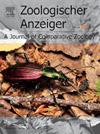东南太平洋两种扇贝(Zygochlamys patagonica和Argopecten purpuratus)苍白眼的比较组织学分析
IF 1.5
3区 生物学
Q2 ZOOLOGY
引用次数: 0
摘要
双壳类软体动物的果胶科的视觉系统是特殊的,因为他们的眼睛的数量和复杂性。果胶虫的非头状眼由角膜、晶状体、双视网膜、色素上皮和凹面镜组成。虽然先前的研究已经解决了果胶眼的解剖和假定功能,但仅在少数扇贝物种中探索了细胞成分及其对不同栖息地的适应。北方扇贝(Argopecten purpuratus)和巴塔哥尼亚扇贝(Zygochlamys patagonica)是重要的水生生物资源,分布在东南太平洋不同纬度(分别为5°S ~ 33°S和40°S ~ 48°S)。本研究利用光学、共聚焦和电子显微镜对这两种动物的白眼进行了表征和比较,以提高我们对它们不同栖息地的感官适应的认识。虽然大多数细胞成分,包括睫状体和横纹肌光感受器,在形态上是相似的,表面上是保守的,但一些结构,如角膜和晶状体,在紫癜和巴塔哥尼察之间显示出显著的差异。总之,果胶眼的细胞复杂性和结构复杂性突出了视觉在扇贝生态和行为中的关键作用。本文章由计算机程序翻译,如有差异,请以英文原文为准。
Comparative histological analysis of the pallial eyes of Zygochlamys patagonica and Argopecten purpuratus, two scallop species from the southeastern Pacific
The visual system of the Pectinidae family of bivalve mollusks is exceptional because of the number and complexity of their eyes. The non-cephalic eyes of pectinids consist of a cornea, a lens, a double retina, a pigment epithelium, and a concave mirror. While prior studies have addressed the anatomy and putative functions of pectinid eyes, the cellular components and their adaptations to different habitats have been explored in only a few scallop species. The Northern scallop Argopecten purpuratus and the Patagonian scallop Zygochlamys patagonica are important hydrobiological resources which inhabit different latitudes in the southeastern Pacific (5°S to 33°S and 40° to 48°S, respectively). The present study characterized and compared the components of the pallial eyes of the two species with light, confocal and electron microscopy, to improve our understanding of the sensory adaptations to their different habitats. While most cellular elements, including the ciliary and rhabdomeric photoreceptors, are morphologically similar and ostensibly conserved, some structures such as the cornea and the lens display significant differences between A. purpuratus and Z. patagonica. Overall, the cellular complexity and structural sophistication of pectinid eyes highlight the critical role of vision in scallop ecology and behavior.
求助全文
通过发布文献求助,成功后即可免费获取论文全文。
去求助
来源期刊

Zoologischer Anzeiger
生物-动物学
CiteScore
2.80
自引率
7.10%
发文量
75
审稿时长
>12 weeks
期刊介绍:
Zoologischer Anzeiger - A Journal of Comparative Zoology is devoted to comparative zoology with a special emphasis on morphology, systematics, biogeography, and evolutionary biology targeting all metazoans, both modern and extinct. We also consider taxonomic submissions addressing a broader systematic and/or evolutionary context. The overall aim of the journal is to contribute to our understanding of the organismic world from an evolutionary perspective.
The journal Zoologischer Anzeiger invites suggestions for special issues. Interested parties may contact one of the editors.
 求助内容:
求助内容: 应助结果提醒方式:
应助结果提醒方式:


